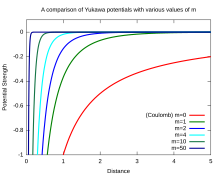Yukawa potential
In particle and atomic physics, a Yukawa potential (also called a screened Coulomb potential) is a potential of the form
where g is a magnitude scaling constant, i.e. is the amplitude of potential, m is the mass of the affected particle, r is the radial distance to the particle, and k is another scaling constant, which finally the product of km is the inverse scope. The first derivative is positive, implying that the potential is monotone increasing, and that implying that the force is always attractive.
The Coulomb potential of electromagnetism is an example of a Yukawa potential with e−kmr equal to 1 everywhere; this is taken to mean that the photon mass m is equal to 0.
In interactions between a meson field and a fermion field, the constant g is equal to the coupling constant between those fields. In the case of the nuclear force, the fermions would be a proton and another proton or a neutron.
History
Hideki Yukawa showed in the 1930s that such a potential arises from the exchange of a massive scalar field such as the field of a massive boson. Since the field mediator is massive the corresponding force has a certain range, which is inversely proportional to the mass of the mediator particle .[1] Because the approximate range of the nuclear force was known, Yukawa's equation could be used to predict the approximate rest mass of the particle mediating the force field, even before it was discovered. In the case of the nuclear force, this mass was predicted to be about 200 times the mass of the electron, and was later considered to be a prediction of the existence of the pion, before it was detected in 1947.
Relation to Coulomb potential


If the mass is zero (i.e., m=0), then the Yukawa potential equals a Coulomb potential, and the range is said to be infinite. In fact, we have:
Consequently, the equation
simplifies to the form of the Coulomb potential
A comparison of the long range potential strength for Yukawa and Coulomb is shown in Figure 2. It can be seen that the Coulomb potential has effect over a greater distance whereas the Yukawa potential approaches zero rather quickly. However, any Yukawa potential or Coulomb potential are non-zero for any large r.
Fourier transform
The easiest way to understand that the Yukawa potential is associated with a massive field is by examining its Fourier transform. One has
where the integral is performed over all possible values of the 3-vector momentum k. In this form, the fraction is seen to be the propagator or Green's function of the Klein–Gordon equation.
Feynman amplitude

The Yukawa potential can be derived as the lowest order amplitude of the interaction of a pair of fermions. The Yukawa interaction couples the fermion field to the meson field with the coupling term
The scattering amplitude for two fermions, one with initial momentum and the other with momentum , exchanging a meson with momentum k, is given by the Feynman diagram on the right.
The Feynman rules for each vertex associate a factor of g with the amplitude; since this diagram has two vertices, the total amplitude will have a factor of . The line in the middle, connecting the two fermion lines, represents the exchange of a meson. The Feynman rule for a particle exchange is to use the propagator; the propagator for a massive meson is . Thus, we see that the Feynman amplitude for this graph is nothing more than
From the previous section, this is seen to be the Fourier transform of the Yukawa potential.
See also
References
Citations
- ^ Brian Robert Martin; Graham Shaw (2008). Particle Physics. p. 18.
Texts
- H. Yukawa, On the interaction of elementary particles. (1935) Proc. Phys. Math. Soc. Japan. 17 48
- Gerald Edward Brown and A. D. Jackson, The Nucleon-Nucleon Interaction, (1976) North-Holland Publishing, Amsterdam ISBN 0-7204-0335-9















